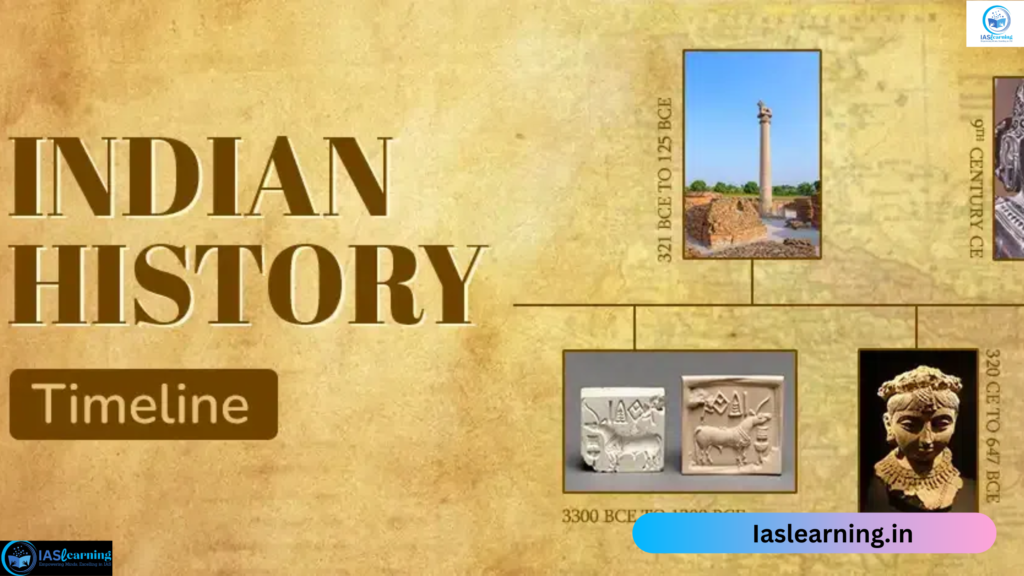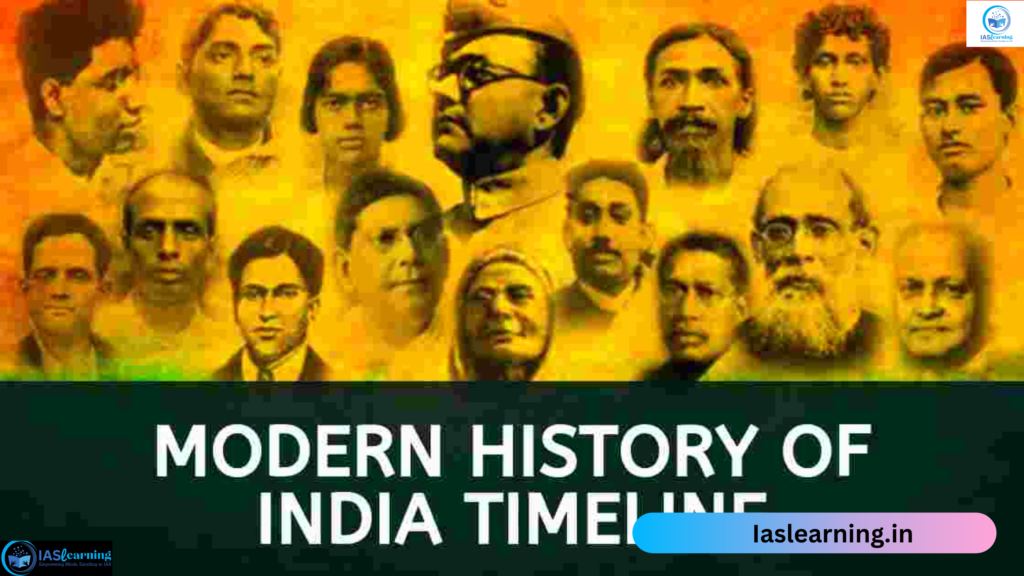Indian History Timeline: The three periods of Indian history are ancient, medieval, and modern. Indian history is organized across thousands of years, from prehistoric to modern times. Indian history is shaped by a range of events, rulers, and societal developments that occur during each time.
Indian History Category
Three periods may be identified in the sequence of Indian history:
- Ancient India
- Medieval India
- Modern India

Indian History Timeline
| Timeline | Event |
| 9000 BCE | Early Neolithic Period |
| 7000 to 3300 BCE | Mehrgarh Culture |
| 3000 to 1500 BCE 3000 – 2600 BCE2600 – 1700 BCE1700 – 1500 BCE | Indus Valley Civilization, Early Harappan Phase, Mature Harappan Phase, Late Harappan Phase |
| 1400 BCE | Complete disappearance of Harappan towns |
| 1500 to 1000 BCE | Early Vedic age, also known as the Rigveda age |
| 1000 BCE | Iron age of India |
| 1000 to 500 BCE | Later Vedic Age |
| 600 BCE | Emergence of 16 Mahajanapadas |
| 563 BCE | Birth of Gautama Buddha (Founder of Buddhism) |
| 540 BCE | Birth of Vardhamana Mahavira (Founder of Jainism) |
| 516 BCE | Penetration of Iranian ruler, Darius into Northwest India |
| 326 BCE | Invasion of India by Alexander of Macedonia (Battle of Hydaspes) |
| 322 BCE | Establishment of the Mauryan dynasty |
| 273 to 232 BCE | Reign of Ashoka |
| 265 BCE | Beginning of Kalinga war |
| 261 BCE | End of the Kalinga war |
| 250 BCE | The Third Buddist Council was held |
| 200 BCE | Beginning of Central Asian contacts and invasion of Bactrian Greeks |
| 184 BCE | The decline of the Mauryan Empire |
| 100 BCE | Establishment of Satavahana Dynasty in Deccan |
| 78 BCE | Shaka era was started by the Kushan ruler, Kanishka |
| 57 BCE | Beginning of the Vikram era |
| Common Era | |
| 78 CE | Gautamiputra Satakarni becomes Satavahana ruler |
| 240 CE | Establishment of the Gupta Empire by Sri Gupta |
| 319 CE | Beginning of the Gupta era by Chandragupta I |
| 319 to 334 CE | Reign of Chandragupta I |
| 335 to 380 CE | Reign of Samudragupta |
| 380 to 412 CE | Reign of Chandragupta II |
| 450 CE | Hunas invasion and end of Gupta Empire |
| 606 to 647 CE | Period of King Harshavardhana |
| 973 to 1190 CE | Reign of Chalukyas of Kalyani |
| 753 CE | Establishment of the Rashtrakuta dynasty by Danti Durga |
| 760 to 1142 CE | Reign of Palas in Eastern India |
| 788 CE | Birth of Adi Sankaracharya |
| 985 to 1014 CE | Reign of Rajaraja Chola |
| 1014 to 1044 CE | Reign of Rajendra Chola |
| 1000 to 1027 CE | Invasion of India by Mahmud of Ghazni |
| 1191 CE | First Battle of Tarain (Mohammad Ghori defeated by Prithviraj III) |
| 1192 CE | Second Battle of Tarain (Prithviraj III defeated by Mohammad Ghori) |
| 1192 to 1206 CE | Ganga-Jamuna doab and its surrounding was under Turkish rule |
| 1206 CE | Establishment of the Delhi Sultanate by Qutbuddin Aibak |
| 1210 CE | Death of Qutbuddin Aibak |
| 1210 to 1236 CE | Reign of Iltutmish |
| 1236 to 1240 CE | Reign of Raziya |
| 1265 to 1287 CE | Reign of Balban |
| 1290 CE | Establishment of the Khalji dynasty by Jalaluddin Khalji |
| 1290 to 1296 CE | Reign of Jalaluddin Khalji |
| 1296 to 1316 CE | Reign of Alauddin Khalji |
| 1320 CE | Establishment of the Tughlaq dynasty by Ghiyasuddin Tughlaq |
| 1320 to 1325 CE | Reign of Ghiyasuddin Tughlaq |
| 1325 to 1351 CE | Reign of Muhammad-bin-Tughlaq |
| 1327 CE | Transfer of capital from Delhi to Daulatabad (by Muhammad-bin-Tughlaq) |
| 1333 CE | Arrival of Ibn Batuta to India |
| 1351 to 1388 CE | Reign of Firuz Tughlaq |
| 1394 to 1412 CE | Reign of Nasiruddin Mahmud |
| 1398 CE | Invasion of Delhi by Timur |
| 1412 CE | The Reign of the Tughlaq dynasty came to an end |
| 1414 to 1451 CE | Reign of the Sayyid dynasty |
| 1451 CE | Establishment of the Lodi dynasty |
| 1451 to 1489 CE | Reign of Bahlul Lodhi |
| 1489 to 1517 CE | Reign of Sikandar Lodhi |
| 1517 to 1526 CE | Reign of Ibrahim Lodhi |
| 1526 CE | First Battle of Panipat |
| 1336 CE | Establishment of the Vijayanagara Empire by Harihara and Bukka |
| 1377 to 1404 | Reign of Harihara II |
| 1404 to 1422 CE | Reign of Deva Raya I |
| 1425 to 1446 CE | Reign of Deva Raya II |
| 1509 CE | Tuluva dynasty was founded by Krishna Deva Raya |
| 1509 to 1530 CE | Reign of Krishnadeva Raya |
| 1565 CE | Battle of Talikota or Battle of Rakshasa-Tangadi. Marked the decline of the Vijayanagara empire |
| 1346 CE | Establishment of Bahmani Kingdom |
| 1327 to 1358 CE | Reign of Ala-ud-din Hasan Bahman Shah |
| 1397 to 1422 CE | Reign of Firuz Shah Bahmani |
| 1419 CE | Defeat of Firuz Shah Bahmani by Deva Raya I |
| 1498 CE | Arrival of Vasco da Gama at Calicut |
| 1510 CE | The Portuguese Governor, Alfonso Albuquerque captured Goa from the ruler of Bijapur. |
| 1526 CE | First Battle of Panipat (Defeat of Ibrahim Lodi by Babur) |
| 1526 CE | Establishment of the Mughal Empire by Babur |
| 1527 CE | Battle of Khanwa |
| 1530 CE | Accession of Humayun to the throne |
| 1539 CE | Defeat of Humayun by Sher Khan at Chausa |
| 1540 CE | Battle of Kanauj between Sher Khan and Mughals |
| 1540 CE | Establishment of Sur Empire by Sher Shah |
| 1555 CE | Humayun recaptured the throne by defeating Sikandur Suri in the Battle of Sirhind. |
| 1556 CE | Accession of Akbar to the throne |
| 1556 CE | Second Battle of Panipat |
| 1556 – 1605 CE | Reign of Akbar |
| 1564 CE | Abolition of the Jizyah system by Akbar |
| 1565 CE | Battle of Talikota and end of Vijayanagar empire |
| 1575 CE | Ibadat Khana (Hall of Prayer) was constructed in Fatehpur Sikri |
| 1576 CE | Battle of Haldighati (Defeat of Maharana Pratap by Akbar) |
| 1581 CE | Promulgation of Din-i-Ilahi by Akbar |
| 1605 to 1627 CE | Reign of Jahangir |
| 1628 to 1658 CE | Reign of Shah Jahan |
| 1658 to 1707 CE | Coronation of Aurangzeb |
| 1679 CE | Jizyah system was reintroduced by Aurangzeb |
| 1707 CE | Death of Aurangzeb |
| 1709 to 1712 CE | Reign of Bahadur Shah I |
| 1712 to 1713 CE | Reign of Jahandar Shah |
| 1713 to 1719 CE | Reign of Farrukhsiyar |
| 1719 to 1748 CE | Reign of Muhammad Shah |
| 1738 to 1739 CE | Persian emperor, Nadir Shah invaded India |
| 1739 CE | Battle of Karnal (Mughals were defeated by Nadir Shah) |
| 1740 to 1748 CE | First Carnatic War |
| 1748 to 1754 CE | Reign of Ahmad Shah |
| 1754 to 1758 CE | Reign of Alamgir II |
| 1757 CE | Battle of Plassey |
| 1758 to 1759 CE | Reign of Shahjehan II |
| 1759 to 1806 CE | Reign of Shah Alam II |
| 1760 CE | Battle of Wandiwash |
| 1761 CE | Third Battle of Panipat |
| 1764 CE | Battle of Buxar |
| 1765 CE | Diwani rights of Bengal, Bihar, and Orissa were granted to the British East India Company by Shah Alam II |
| 1765 to 1772 CE | Dual Government in Bengal |
| 1767 to 1769 CE | First Anglo-Mysore war |
| 1770 CE | Great Bengal Famine |
| 1772 CE | Warren Hastings was appointed as Governor of Bengal |
| 1772 CE | Abolition of dual government in Bengal |
| 1773 CE | The Regulating Act of 1773 was passed |
| 1775 to 1782 CE | First Anglo-Maratha war |
| 1776 CE | Treaty of Purandhar |
| 1780 to 1784 CE | Second Anglo-Mysore war |
| 1782 CE | Treaty of Salbai |
| 1784 CE | Pitt’s India Act was passed |
| 1786 to 1793 CE | Lord Cornwallis served as the Governor-General |
| 1790 to 1792 CE | Third Anglo-Mysore War and Treaty of Srirangapatnam (1792) |
| 1793 CE | The Charter Act of 1793 was passed |
| 1793 to 1798 CE | Sir John Shore served as the Governor-General |
| 1798 CE | Lord Wellesley was appointed as Governor-General |
| 1798 CE | Introduction of Subsidiary Alliance |
| 1799 CE | Fourth Anglo-Mysore war |
| 1802 CE | Treaty of Bassein |
| 1803 to 1805 CE | Second Anglo-Maratha war |
| 1806 to 1837 CE | Reign of Akbar II |
| 1807 to 1813 CE | Lord Minto served as the Governor-General |
| 1813 CE | The Charter Act of 1813 was passed |
| 1813 to 1823 CE | Lord Warren Hastings served as the Governor-General |
| 1817 to 1819 CE | Third Anglo-Maratha war |
| 1823 to 1828 CE | Lord Amherst served as the Governor-General |
| 1828 CE | Brahmo Sabha was founded by Raja Rammohan Roy |
| 1828 to 1835 CE | Lord William Bentinck served as the Governor-General |
| 1833 CE | The Charter Act of 1833 was passed |
| 1836 to 1842 CE | Lord Auckland served as the Governor-General |
| 1837 to 1857 CE | Reign of Bahadur Shah II and the end of the Mughal empire |
| 1842 to 1844 CE | Lord Ellenborough served as the Governor-General |
| 1844 to 1848 CE | Lord Hardinge served as the Governor-General |
| 1845 to 1846 CE | First Anglo-Sikh War |
| 1848 to 1849 CE | Second Anglo-Sikh War |
| 1848 to 1856 CE | Lord Dalhousie served as the Governor-General |
| 1853 CE | The Charter Act of 1853 was passed |
| 1854 CE | Charles Wood’s despatch on Education |
| 1856 to 1858 CE | Lord Canning served as the Governor-General |
| 1857 CE | Revolt of 1857 |
| 1858 CE | Lord Canning was appointed as the Viceroy |
| 1861 CE | Indian Council Act of 1861 was passed |
| 1861 CE | Indian Civil Service Act of 1861 was passed |
| 1862 to 1863 CE | Lord Elgin served as Viceroy |
| 1864 to 1869 CE | Sir John Lawrence served as Viceroy |
| 1866 CE | East India Association was formed by Dadabhai Naoroji |
| 1867 CE | Poona Sarvajanik Sabha was founded by M.G.Ranade |
| 1869 to 1872 CE | Lord Mayo served as Viceroy |
| 1875 CE | Arya Samaj founded by Swami Dayananda |
| 1876 CE | Indian National Association was formed by Surendranath Banerjea and Ananda Mohan Bose |
| 1878 CE | The Vernacular Press Act was passed |
| 1880 to 1884 CE | Lord Ripon served as Viceroy |
| 1883 to 1884 CE | Ilbert Bill Controversy |
| 1884 to 1888 CE | Lord Dufferin served as Viceroy |
| 1885 CE | The first session of the Indian National Congress |
| 1888 to 1893 CE | Lord Lansdowne served as Viceroy |
| 1892 CE | Indian Councils Act of 1892 was passed |
| 1893 to 1899 CE | Lord Elgin II served as Viceroy |
| 1899 to 1905 CE | Lord Curzon served as Viceroy |
| 1905 CE | Partition of Bengal |
| 1905 to 1910 CE | Lord Minto II served as Viceroy |
| 1906 CE | Swaraj was declared the goal of the Congress by Dadabhai Naoroji |
| 1906 CE | Formation of the Muslim League |
| 1907 CE | Surat Split of the Congress |
| 1907 CE | Seditious meeting act was passed |
| 1908 CE | Indian Newspapers Act was passed |
| 1909 CE | Morley-Minto Reforms |
| 1909 CE | Indian Councils Act of 1909 was passed |
| 1910 CE | Indian Press Act was passed |
| 1910 to 1916 CE | Lord Hardinge II served as Viceroy |
| 1911 CE | Annulment of Bengal Partition of 1905 |
| 1914 to 1919 CE | First World War |
| 1914 CE | The arrival of Mohandas Karamchand Gandhi in India |
| 1916 to 1921 CE | Lord Chelmsford served as Viceroy |
| 1916 CE | Home Rule League was set up by Tilak and Annie Besant |
| 1916 CE | Lucknow pact between Congress and Muslim League |
| 1916 CE | Readmission of Extremists into Congress at Lucknow session of Congress |
| 1917 CE | August declaration was made by Edwin Samuel Montagu |
| 1917 CE | Champaran Satyagraha |
| 1918 CE | Ahmedabad Mill Strike |
| 1918 CE | Kheda Satyagraha |
| 1919 CE | Montagu-Chelmsford Reform was introduced |
| 1919 CE | Government of India Act of 1919 was passed |
| 1919 CE | Rowlatt Act was passed |
| 1919 CE | Jallianwala Bagh Massacre |
| 1920 CE | Khilafat and Non-Cooperation Movement |
| 1920 to 1930 CE | Several revolutionary movements took place |
| 1921 to 1926 CE | Lord Reading served as Viceroy |
| 1922 CE | Chauri Chaura incident |
| 1926 to 1931 CE | Lord Irwin served as Viceroy |
| 1927 CE | All India Women’s Conference was founded by Margaret Cousins |
| 1927 CE | Appointment of Simon Commission |
| 1928 CE | Nehru Report was put forth |
| 1929 CE | Jinnah’s Fourteen points were proposed |
| 1930 CE | Gandhiji’s Dandi March and Civil Disobedience Movement |
| 1930 to 1931 CE | First-round Table Conference |
| 1931 CE | Second Round Table Conference |
| 1931 CE | Gandhi-Irwin Pact |
| 1931 to 1936 CE | Lord Wellingdon served as Viceroy |
| 1932 CE | Third Round Table Conference |
| 1932 CE | Announcement of communal award |
| 1932 CE | Poona Pact was signed |
| 1935 CE | Government of India Act of 1935 was passed |
| 1936 to 1944 CE | Lord Linlithgow served as Viceroy |
| 1939 to 1945 CE | Second World War |
| 1940 CE | August Offer was announced |
| 1942 CE | Cripps Mission headed by Sir Stafford Cripps was sent to India |
| 1943 CE | The Bengal Famine |
| 1944 to 1947 CE | Lord Wavell served as Viceroy |
| 1945 CE | Wavell Plan |
| 1946 CE | Cabinet Mission was sent to India |
| 1947 CE | Mountbatten Plan was announced |
| 1947 CE | Indian Independence Act was passed |
| 1947 CE | Partition of India into India and Pakistan |
| 1948 CE | Assasination of Gandhi |
| 1949 CE | The Constitution of India was adopted |
| 1950 CE | The Constitution of India came into force |
For more : Ahmedabad Mill Strike: First Hunger Strike,1918
Ancient Indian Chronology
Prehistoric Times:
- Paleolithic Era (between 2 million and 10,000 BC):
characterized by the use of stone tools, the finding of fire, and important locations such as the Narmada Valley, Bhimbetka, and Hunsgi.
- The Mesolithic Period (between 10,000 and 8,000 BC):
major climate changes, animal domestication, and the introduction of microliths.
- Neolithic Period (8000–2000 BC): Hallur and Burzahom are important sites, agriculture begins, and the wheel is developed.
- Chalcolithic Period (4000–1500 BC): Often referred to as the Bronze Age’s Copper Age.
- Iron Age (1500–200 BC): Denotes the beginning of the Vedic Period and the advent of the Aryans.
Vedic Period
During the Early Vedic Period (1500 BC–1000 BC)
Aryans arrived and settled in the northwest.
The earliest of the Vedas, the Rig Veda, is written.
- Early Vedic religion and culture developed.
- The Indo-Gangetic Plain saw the spread of Aryan culture during the Later Vedic Period (1000–500 BC).
- Yajur, Sama, and Atharva, the other three Vedas’ composition.
- the development of the caste system and the advent of Brahmanism.
During the Mahajanapadas Period (600-300 BC)
- 16 significant states, or Mahajanapadas, were formed. Trade and metropolitan hubs are growing. formation of the first republics and political bodies.
The rise of Jainism and Buddhism (about the sixth century BC):
- Gautama Buddha’s introduction of Buddhism.
- Mahavira’s The Rise of Jainism.
- challenge to the religion of the Vedas.
Greek and Persian invasions (c. 550–300 BC):
- Achaemenid Empire administration and culture were influenced by Persians.
- The invasion of Alexander the Great, which has a long-lasting effect on the terrain of culture
Mauryan Empire (321–185 BC):
- A vast empire is founded by Chandragupta Maurya during the Mauryan Empire (321–185 BC).
- The kingdom reached its zenith under Ashoka’s rule, who is credited with promoting Buddhism.
Post-Mauryan Kingdoms:
- the Satavahana dynasty, Kanva, and Sunda (after 185 BC).
- In the absence of a centralized government, regional powers emerge.
The Gupta Empire, which ruled from around 320 to 550 AD
- The Gupta Empire, which ruled from around 320 to 550 AD, is sometimes called India’s Golden Age.
- notable advances in literature, science, and the arts.
- creation of a powerful national government and thriving commerce.
Post-Gupta Period (550 AD onward):
- Regional kingdoms rose to prominence as the empire fragmented.
- commerce and cultural stability in the face of political change.
For more : Evolution of Judiciary During British Times
Indian Renaissance Short Notes
Medieval Indian Chronology (AD 700–AD 1857)
In medieval India, the years 8th to the 18th centuries are included in the chronology. Several strong empires rose and fell throughout this time.
Early Medieval Period (AD 700–AD 1200)
Tripartite struggle (AD 800-1200):
- A fight for dominance between the Pratiharas, Palas, and Rashtrakutas over the Gangetic plains.
- important in influencing the political climate in North India.
Rise of Regional Kingdoms:
- In the South, strong regional dynasties such as the Pallavas, Chalukyas, and Cholas emerged.
- These kingdoms left a significant mark on Indian literature, architecture, and culture.
High Medieval Period (AD 1200–AD 1526)
Establishment of the Delhi Sultanate (1206 AD–1526 AD):
- The entrance of the Turks and the establishment of Muslim power in North India marked the beginning of the Delhi Sultanate (1206 AD–1526 AD).
- These were the dynasties that came after each other: the Sayyid, Khilji, Tughlaq, Lodi, and Mamluk/Slave.
- the growth and stabilization of Muslim dominance throughout the Indian subcontinent.
Attacks from Central Asia:
- The Delhi Sultanate briefly declined in 1398 as a result of Timur’s (Tamerlane’s) raids.
- Establishing libraries and madrasas.
- The Qutub Minar and the Red Fort are two examples of the growth of Indo-Islamic architecture.
- commerce growth with Southeast Asia and the Middle East.
- expansion of major cities like Lahore, Delhi, and Agra.
Late Medieval Period (AD 1526–AD 1857)
Mughal Empire (AD 1526–AD 1857):
- Babur founded the Mughal Empire in 1526 following the First Battle of Panipat, which lasted until AD 1857.
- Under Akbar, Jahangir, Shah Jahan, and Aurangzeb, it peaked.
- renowned for its accomplishments in culture, military might, and administrative effectiveness.
Maratha Ascendancy:
- In the seventeenth century, Shivaji led the Maratha Empire to its peak.
- developed to be a significant force in India, disruptive the Mughal and then the European powers.
European Colonization:
- Traders and colonists from Europe, particularly the Portuguese, Dutch, French, and British, arrived.
- Colonial dominance resulted from the founding of commercial stations and associated political power.
- The Mughal Empire gradually weakened, particularly after Aurangzeb.
- emergence of regional powers like as the Rajputs, Sikhs, Jats, and Hyderabadi Nizams.
- expansion of social and religious reform groups, like as Sikhism, under the leadership of Guru Nanak and his gurus.
Emergence of Independent Kingdoms:
- Bengal, Awadh, and Mysore are examples of the formation of independent and semi-independent kingdoms.
- These states were instrumental in the opposition against British expansion.
India’s medieval history was characterized by a wide range of political, social, and cultural changes. It made a substantial contribution to the rich and varied legacy of the Indian subcontinent by laying the groundwork for the later colonial era and the contemporary era.
Modern Indian Chronology
Beginning in the middle of the 18th century, modern Indian history is characterized by significant events that finally brought to the fall of traditional kingdoms, the emergence of British colonialism, and the creation of a contemporary, independent nation.

A timeline of significant occurrences during this time period is shown below:
Colonial Era (Mid-18th Century–1947)
Establishment of British Rule:
- British rule was established in 1757 after the Battle of Plassey established British dominance in Bengal.
- The Battle of Buxar in 1764 established British dominance in India.
British Expansion and Administration:
- In India in the late 18th and early 19th centuries, British power was gradually extended.
- introduction of legislative and administrative changes, including as the Civil Services, Ryotwari System, and Permanent Settlement.
Socio-Religious Reform Movements:
Early to mid-19th century: the rise of social reformers like Raja Ram Mohan Roy and Ishwar Chandra Vidyasagar, as well as the formation of reform groups like Brahmo Samaj and Arya Samaj.
The Revolt of 1857:
- the Sepoy Mutiny against British authority, also known as the First War of Indian Independence.
- As a result, the East India Company’s dominance came to an end, and the British Crown took direct control of India.
Nationalist Movements and Congress Foundation:
- 1885: The Indian National Congress was founded.
- Home Rule and the Swadeshi Movement in the early 20th century.
Gandhian Era and Mass Movements:
- Mahatma Gandhi’s return from South Africa in 1915 marked the start of the Gandhian period in the Indian liberation movement.
- 1919: Rowlatt Act demonstrations; the Jallianwala Bagh Massacre.
- The Non-Cooperation Movement in 1920.
- 1930: Salt Satyagraha; Civil Disobedience Movement.
- Quit India Movement, 1942.
Partition and Independence:
- 1947 marked the partition of India, its release from British domination, and the birth of Pakistan and India.
- India’s first prime minister after independence was Jawaharlal Nehru.
Indian History Chronology – FAQs
Q1.What is the order of Indian history?
Ans. Indian history is arranged as follows: ancient, medieval, and modern.
Q2.What is the timeline of Indian history?
Ans. The following is an outline of Indian history:
From 2 million BC to 550 AD, ancient history
The Middle Ages: AD 700–AD 1857
Modern History, Mid-1800s–1947
Q3.What is the timeline of ancient Indian history?
Ans. Prehistoric periods are the beginning of the ancient Indian history chronology, which ends in 550 AD.
Prehistoric Times:
the Chalcolithic Period (4000 BC–1500 BC), the Neolithic Period (8000 BC–2000 BC), the Mesolithic Period (10,000 BC–8,000 BC), and the Iron Age (1500 BC–200 BC)
The Early Vedic Period, around 1500–1000 BC
The Later Vedic Era (ca. 1000–500 BC)
Period of the Mahajanapadas (600–300 BC)
Rise of Buddhism and Jainism (ca. 6th century BC)
Empire of Mauryans (321–185 BC)
Gupta Dynasty (c. 320–550 AD)
Q4.What is the medieval history chronology in India?
Ans. There are three sub-periods that may be used to understand the chronology of medieval Indian history:
The Early Middle Ages (AD 700–1200)
Conflict in Three Parts (AD 800-1200)
The High Middle Ages (AD 1200–AD 1526)
The Delhi Sultanate was founded (1206 AD–1526 AD).
The Late Middle Ages (AD 1526–AD 1857)
Empire of Mughals (AD 1526–AD 1857)




